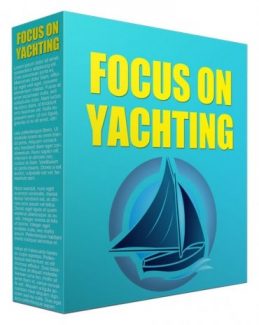
 License Type: Private Label Rights
License Type: Private Label Rights  File Type: ZIP
File Type: ZIP
 SKU: 60427
SKU: 60427  Shipping: Online Download
Shipping: Online Download
Sample Content Preview
Aren’t for Everyone! Yachts Aren’t for Everyone! Yachts Aren’t for Everyone! Yachts Aren’t for Everyone! Yachts Aren’t for Everyone! Yachts Aren’t for Everyone! Yachts Aren’t for Everyone! Yachts Aren’t for Everyone!
Owning a yacht is by no means a small financial venture. Yachts can range in price from a few thousand dollars to basically unlimited. It’s not rare to see them auctioning for more than a few million dollars. Even if you opt for a less expensive yacht you have to consider maintenance.
Every year you can expect to spend about 10% of the total price of your yacht in maintenance. A Yacht is a type of boat; as such it will be in the water for most of its life. Constant contact with the elements and with water takes its toll. This is amplified ten-fold if you have your yacht on sea water. Salt and other minerals wreak absolute havoc on the exterior of the yacht as well as the mechanical components inside.
Aside from initial cost and maintenance, you get to worry about licenses and permits to use your yacht depending on where you live. If you’re yacht is bound for sea, you’ll probably want to have a port to keep it at. Most of these places will have a monthly rate of around $15/ft. and usually have a minimum (such as 30 ft. minimum). For an average-sized yacht of 45ft you’re looking at $675 a month, just for your yacht to have a place to stay!
Before you decide if owning a yacht is really for you, make sure you consider the financial and logistical challenges that lay ahead. Owning a yacht is an extremely fun and rewarding experience that you’ll enjoy for years to come. All the same, if you’re not financially or mentally prepared to own and maintain a yacht, it could be a decision you end up regretting some time down the road. If you’re sure that you are fully prepared to enter the world of yacht ownership, or at least yacht enthusiasm, then let’s get started! We’ll start at the bare-bones basics and before you know it you’ll be a veritable expert on what a yacht is, how you can buy or rent one and where you should take it once you get it!
What is a Yacht? What is a Yacht? What is a Yacht?What is a Yacht? What is a Yacht? What is a Yacht? What is a Yacht?
A yacht is a recreational boat, often of a luxury variety. The term originated from the Dutch Jacht meaning "hunt.” It was originally defined as a light, fast sailing vessel used by the Dutch navy to pursue pirates and other transgressors around and into the shallow waters of the Low Countries. After its selection by Charles II of England as the vessel of choice to return to Britain from Holland for his restoration, it came to be used to convey important persons.
In modern use the term designates two rather different classes of watercraft, sailing and power boats. Yachts are different from working ships mainly by their leisure purpose, and it was not until the rise of the steamboat and other types of powerboat that sailing vessels in general came to be perceived as luxury, or recreational vessels. Later the term came to encompass motor boats for primarily private pleasure purposes as well.
Yacht lengths generally range from 20 feet up to hundreds of feet. A luxury craft that is smaller than 40 feet is more commonly called a cabin cruiser or simply a "cruiser." A mega yacht generally refers to any yacht (sail or power) above 100 ft. and a super yacht generally refers to any yacht over 200 ft. This size is small in relation to typical cruise liners and oil tankers.
History
Yacht (pronounced like “Yott” where it rhymes with “pot”) was originally defined as a light, fast sailing vessel used by the Dutch navy to pursue pirates and other transgressors around and into the shallow waters of the Low Countries. They were also used for non-military governmental roles such as customs duties and delivering pilots to waiting ships. The latter use attracted the attention of wealthy Dutch merchants who began to build private yachts so they could be taken out to greet their returning ships.
Soon wealthy individuals began to use their 'Jachts' for pleasure trips. By the start of the 17th century 'Jachts' came in two broad categories- speel-jachts for sport and oorlog-jachts for naval duties. By the middle of the century large 'jacht' fleets were found around the Dutch coast and the Dutch states organized large 'reviews' of private and war yachts for special occasions, thus putting in place the groundwork for the modern sport of yachting. Jachts of this period varied greatly in size, from around 40 ft. in length to being equal to the lower classes of the ship of the line. All had a form of fore/aft gaff rig with a flat bottom and lee boards to allow operations in shallow waters. The gaff rig remained the principal rig found on small European yachts for centuries until giving way to the 'Bermudan sloop' rig in the 1960s.
Charles II of England spent part of his time in exile during the period of the Commonwealth of England in the Netherlands and became keen on sailing. He returned to England in 1660 aboard a Dutch yacht. During his reign Charles commissioned 24 Royal Yachts on top of the two presented to him by Dutch states on his restoration. As the fashion for yachting spread throughout the English aristocracy yacht races began to become common. Other rich individuals in Europe built yachts as the sport spread. Yachting therefore became a purely recreational form of sailing with no commercial or military function, which still serves a broad definition of both the sport and of the vessel.
How Are Yachts Made?
Until the 1950s, almost all yachts were made of wood or steel, but a much wider range of materials is used today. Although wood hulls are still in production, the most common construction material is fiberglass, followed by aluminum, steel, carbon fiber, and ferro-cement (rarer because of insurance difficulties). The use of wood has changed and is no longer limited to traditional board-based methods, but also includes modern products such as plywood, veneers and epoxy resins. Wood is mostly used by hobbyists or wooden boat purists when building an individual boat.
Classifications of Yachts
Sailing yachts
Sailing yachts can range in overall length (Length Over All—LOA, in yachting parlance) from about 20 ft. to well over 100 ft., where the distinction between a yacht and a ship becomes blurred. Most privately owned yachts fall in the range of about 25–45 ft.; the cost of building and keeping a yacht rises quickly as length increases. In the U.S., sailors tend to refer to smaller yachts as sailboats, while referring to the general sport of sailing as yachting. Within the limited context of sailboat racing, a yacht is any sailing vessel taking part in a race, regardless of size.
Modern yachts have efficient sail-plans, most notably the Bermuda rig, that allows them to sail towards the wind. This capability is the result of a sail-plan and hull design.
Day sailing yachts
Day sailing yachts are usually small, at less than 20 ft. in length. Sometimes called dinghies, they often have a retractable keel, centerboard, or dagger board. Most day-sailing yachts do not have a cabin, as they are designed for hourly or daily use and not for overnight journeys. At best they may have a 'cubby', where the front part of the hull has a raised solid roof to provide a place to store equipment or to offer basic shelter from wind or spray.
Weekender yachts
Weekender yachts are slightly larger, at less than 30 ft. in length. They often have twin keels or lifting keels such as in trailer sailors. This allows them to operate in shallow waters, and if needed "dry out"—become beached as the tide falls. The hull shape (or twin-keel layout) allows the boat to sit upright when there is no water. Such boats are designed to undertake short journeys, rarely lasting more than 2 or 3 days (hence their name).
In coastal areas, long trips may be undertaken in a series of short hops. Weekenders usually have only a simple cabin, often consisting of a single "saloon" with beds pace for two to three people. Clever use of ergonomics allows space in the saloon for a galley (kitchen), seating, and navigation equipment. There is limited space for stores of water and food.
Most are single-misted "Bermuda sloops" (not to be confused with the type of traditional Bermudian ship known as a Bermuda sloop), with a single foresail of the jib or genoa type and a single mainsail (one variation of the aforementioned Bermuda rig). Some are gaff rigged. The smallest of this type, generally called pocket yachts or pocket cruisers, and trailer sailors can be transported on special trailers.
Cruising yachts
Cruising yachts are by the far the most common yacht in private use, making up most of the 25 to 45 ft. range. These vessels can be quite complex in design, as they need a balance between docile handling qualities, interior space, good light-wind performance and on-board comfort. The huge range of such craft, from dozens of builders worldwide, makes it hard to give a single illustrative description. However, most favor a teardrop-planform hull, with a wide, flat bottom and deep single-fin keel to give good stability. Most are single-masted Bermuda rigged sloops, with a single fore-sail of the jib or Genoa type and a single mainsail.
Spinnaker sails, in various sizes, are often supplied for down-wind use. These types are often chosen as family vessels, especially those in the 26 to 40-foot range. Such a vessel will usually have many cabins below deck. Typically there will be three double-berth cabins; a single large saloon with galley, seating and navigation equipment; and a "head" consisting of a toilet and shower-room.
Most large yachts, 50 ft. and up, are also cruisers, but their design varies greatly as they are often "one off" designs tailored to the specific needs of the buyer. The interior is often finished in wood paneling, with plenty of storage space. Cruisers are quite capable of taking on long-range passages of many thousands of miles. Such boats have a cruising speed upwards of 6 knots. This basic design is typical of the standard types produced by the major yacht-builders.
- License: Private Label Rights
- Category:Ebooks
- Tags:2017 Ebooks Private Label Rights







